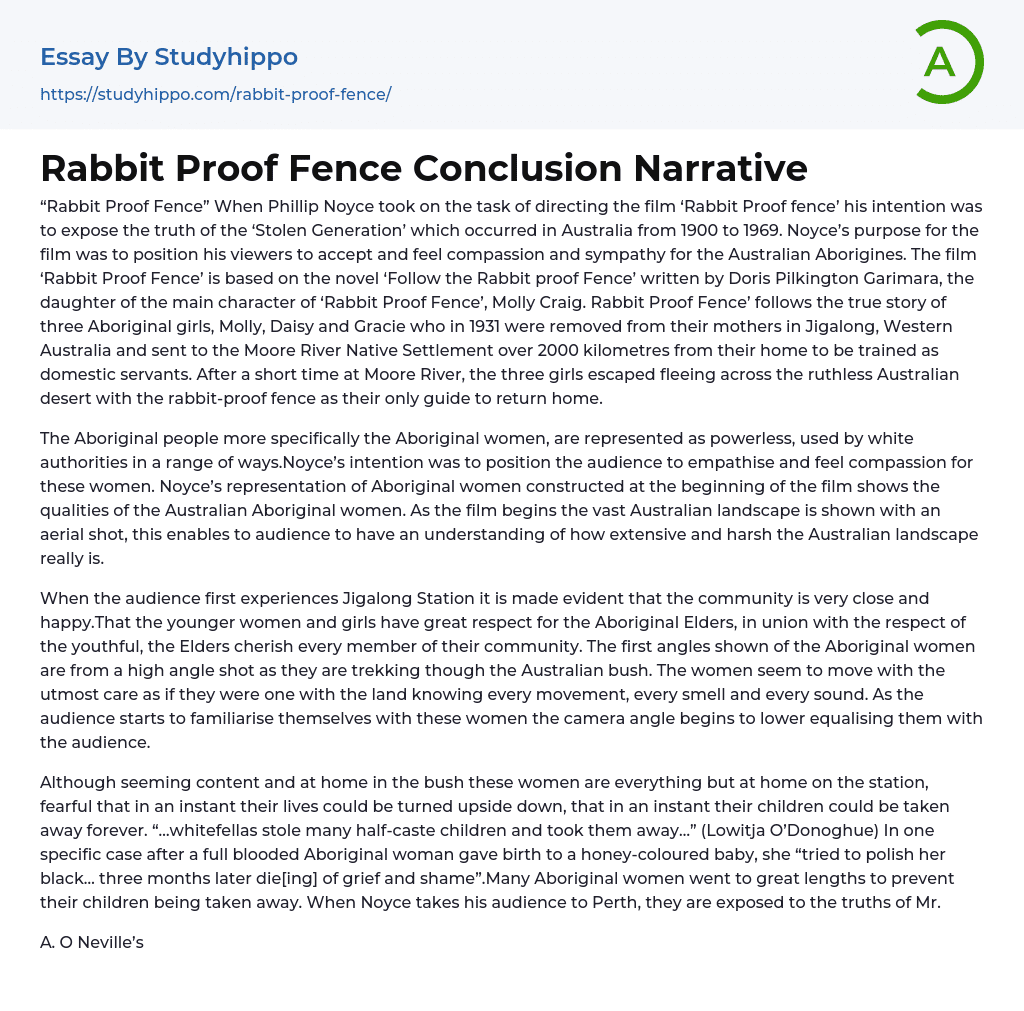“Rabbit Proof Fence” When Phillip Noyce took on the task of directing the film ‘Rabbit Proof fence’ his intention was to expose the truth of the ‘Stolen Generation’ which occurred in Australia from 1900 to 1969. Noyce’s purpose for the film was to position his viewers to accept and feel compassion and sympathy for the Australian Aborigines. The film ‘Rabbit Proof Fence’ is based on the novel ‘Follow the Rabbit proof Fence’ written by Doris Pilkington Garimara, the daughter of the main character of ‘Rabbit Proof Fence’, Molly Craig. Rabbit Proof Fence’ follows the true story of three Aboriginal girls, Molly, Daisy and Gracie who in 1931 were removed from their mothers in Jigalong, Western Australia and sent to the Moore River Native Settlement over 2000 kilometres from their home to be trained as domestic servants. After a short time at
...Moore River, the three girls escaped fleeing across the ruthless Australian desert with the rabbit-proof fence as their only guide to return home.
The Aboriginal people more specifically the Aboriginal women, are represented as powerless, used by white authorities in a range of ways.Noyce’s intention was to position the audience to empathise and feel compassion for these women. Noyce’s representation of Aboriginal women constructed at the beginning of the film shows the qualities of the Australian Aboriginal women. As the film begins the vast Australian landscape is shown with an aerial shot, this enables to audience to have an understanding of how extensive and harsh the Australian landscape really is.
When the audience first experiences Jigalong Station it is made evident that the community is very close and happy.That the younger women and girl
have great respect for the Aboriginal Elders, in union with the respect of the youthful, the Elders cherish every member of their community. The first angles shown of the Aboriginal women are from a high angle shot as they are trekking though the Australian bush. The women seem to move with the utmost care as if they were one with the land knowing every movement, every smell and every sound. As the audience starts to familiarise themselves with these women the camera angle begins to lower equalising them with the audience.
Although seeming content and at home in the bush these women are everything but at home on the station, fearful that in an instant their lives could be turned upside down, that in an instant their children could be taken away forever. “…whitefellas stole many half-caste children and took them away…” (Lowitja O’Donoghue) In one specific case after a full blooded Aboriginal woman gave birth to a honey-coloured baby, she “tried to polish her black… three months later die[ing] of grief and shame”.Many Aboriginal women went to great lengths to prevent their children being taken away. When Noyce takes his audience to Perth, they are exposed to the truths of Mr.
A. O Neville’s intention to ‘breed them out’, as if they were animals. The shot of the Aboriginal women lining the footpath and steps outside of A. O. Neville’s office assisted to put a face to that of the women and the horrible situation occurring.
Noyces choice of camera angle in this particular scene marginalises the two races as it perceives Noyce to have authority.The slide show that A. O Neville presents to the
white women verifies this and shapes the audience to feel a sense of guilt and sympathy for the Aboriginal women. “Much as we sympathise with the mother-love of the lubras, we say that the half-caste children should be segregated. ” (Stuart Rintoul) Aboriginal women were used as domestic servants commonly being victimised by European men, as they were irrelevant parts of their lives.Things such as using them for sex were common “[a]ll Aboriginal women are prostitutes at heart” (Hans Sherrer, Sydney Morning Herald 2003).
If the women were not domestic servants they still managed to exploit the Aboriginal women “they traded with Aboriginal men for dingo scalps and slept their women…”(Stuart Rintoul) In “Rabbit Proof Fence” Noyce allows the audience to witness this when Molly, Daisy and Gracie take refuge with the domestic servant on their journey home to Jigalong.As the girls near home, their determination and hope become stronger. This is reflected when Noyce’s shot of Molly and her mother holding on to the rabbit-proof fence is shown. This symbolises a sense of connection even though they are miles away from one another and that the bond of mother and daughter is irreplaceable, only to be understood by the two alone.
- Australian Culture essays
- Afghanistan essays
- Africa essays
- America essays
- Asia essays
- Australia essays
- Caribbean essays
- City essays
- Developing Country essays
- Dubai essays
- Earthquake essays
- Europe essays
- Fracking essays
- Georgia essays
- Middle East essays
- Natural Disaster essays
- New Zealand essays
- North Korea essays
- South Korea essays
- Thailand essays
- Travel essays
- 12 Angry Men essays
- A beautiful mind essays
- A Separation essays
- Alfred Hitchcock essays
- American Beauty essays
- American Films essays
- Animation essays
- Avatar essays
- Blade Runner essays
- Bollywood essays
- Bond essays
- Bridge essays
- Cinema Of The United States essays
- Comedies essays
- David essays
- Dead Poets Society essays
- Do The Right Thing essays
- Documentary essays
- English-Language Films essays
- Erin Brockovich essays
- Film Analysis essays
- Film Editing essays
- Film Noir essays
- Film Techniques essays
- Finding Forrester essays
- Forrest Gump essays
- Gattaca essays
- Gladiator essays
- Glory essays




